News of the Cock Lane Ghost spread throughout
London, and sightseers, sympathetic, sceptical and curious, flocked to the
house eager to hear the spectre vulgarly dubbed ‘Scratching Fanny’. Thousands
appeared, savvy entrepreneurs made money by selling their places close to the
door, and Parsons himself cashed in on the appeal of his haunted house by
charging an admission fee.
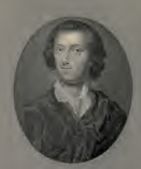 |
| Horace Walpole |
Horace Walpole, in a letter dated February 2nd
1762, wrote about his visit to Cock Lane with the Duke of York, Lady Northumberland,
Lady Mary Coke and Lord Hertford, telling how fifty people were crammed into a
tiny room lit by a single tallow candle, and how
“… the Methodists have promised them contributions; provisions are sent in like forage, and all the taverns and ale-houses in the neighbour-hood make fortunes.”
William Kent
found himself in a particular quandary – he could hardly bring charges against
a ghost, yet his name was on the lips of the whole of London. He sought out
Esther Carlisle, his late wife’s maid, called ‘Carrots’ on account of her red
hair, who confirmed that Fanny had not mentioned anything regarding a suspicion
that she had been poisoned and, indeed, for the last twelve hours of her life
she had said nothing to her at all. The doctor and the apothecary who had
attended Fanny swore affidavits that she had died of smallpox, and yet every
night the unquiet spirit repeated its accusations against Kent. On February 1st
1762, the incumbent of St John’s Clerkenwell, Rev Stephen Aldrich convened a
committee of investigators, on the orders of Samuel Fludyer, Lord Mayor of
London, which included, amongst others, Dr Samuel Johnson.
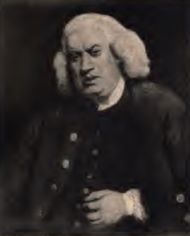 |
| Dr Samuel Johnson |
With Parsons’
permission, Elizabeth was taken to Aldrich’s house and at ten o’clock,
ladies-in-waiting from a nearby maternity hospital put the child to bed, and an
hour later the company assembled at the bedside. The ghost of Scratching Fanny
was present, said the child, as she could feel her like a mouse upon her back,
and through knocks and raps, it was ascertained that the spirit would attend
the vault beneath St John’s, where it would knock upon the coffin lid, proving
the veracity of its claims. The company went straight to the church and William
Kent and a witness went down into the vault but nothing was heard from the
spirit, and in Dr Johnson’s words,
“It is therefore the opinion of the whole assembly, that the child has some art of making or counterfeiting particular noises, and that there is no agency of any higher cause.”
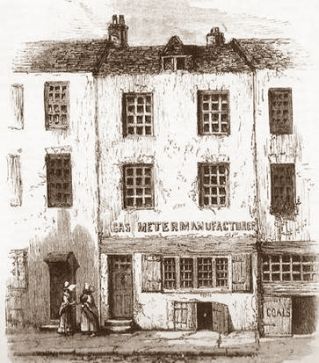 |
| The House in Cock Lane |
The Parsons let
it be known shortly afterwards that the promised revelation had failed because
Mr Kent had removed Fanny’s coffin from the church vault and Kent had little
recourse but to return to the crypt with credible witnesses, point out the
particular casket, which was then opened and the contents examined to confirm
that they were the remains of his deceased partner. Elizabeth Parsons was again
examined and tested, and was told in no uncertain terms that unless Scratching
Fanny appeared to order, she and her father would be committed to Newgate
Prison.
 |
| The True Portrait of the Ghost |
As the child was being prepared for bed, the maids attending her
noticed her take a piece of wood, on which the kettle normally stood, from the
chimney and hide it in her nightdress. Late in February 1762, a pamphlet
appeared, The Mystery Revealed, which supported Kent’s case and,
although published anonymously, was written by the poet Oliver Goldsmith (he
was paid three guineas).
 |
| Oliver Goldsmith - The Mystery Revealed - 1762 |
Understandably fed up with the whole charade, Kent
indicted Parsons, his wife, his daughter, their servant, the Rev Moore and a
tradesman from Cock Lane on charges of conspiracy, and on July 10th
1762, they were brought before the Court of the King’s Bench, with Lord
Chief-Justice William Murray, 1st Earl of Mansfield presiding. The
trial took twelve hours, Murray spent ninety minutes summing up and the jury
spent fifteen further minutes in consideration before returning a verdict of
guilty on all concerned. There was a considerable delay in sentencing, as the
parties found it difficult to agree on the level of compensation, but by the following
February, the clergyman John Moore and the tradesman Richard James agreed to
pay the sum of between five and six hundred pounds each.
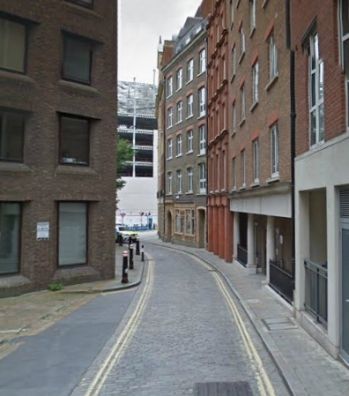 |
| Modern Cock Lane |
The Parsons’ servant,
Mary Frazer, was sentenced to six months imprisonment with hard labour in the
Bridewell, Mrs Parsons was sentenced to twelve months imprisonment with hard
labour and Richard Parsons was given two years in gaol, and was made to stand
three times in the pillory, once at the end of Cock Lane. Such was the public
sympathy that, rather being pelted with rotten vegetables and stones, a
collection was taken up for him, as he stood displayed in disgrace. A printer,
who had been engaged by the Parsons to produce a book about their haunting, was
fined fifty pounds and discharged. The child, Elizabeth, was said to have
grown, married twice and to have lived until 1807.
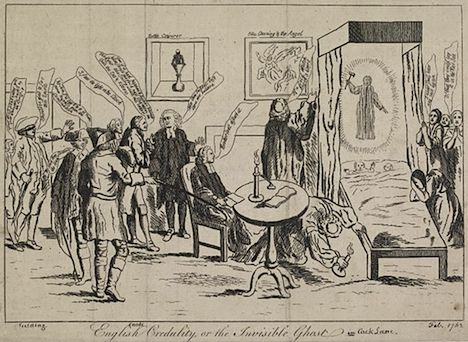 |
| English Credulity, or the Invisible Ghost |
It appears that the motive
behind the whole imposture was revenge – Parsons seeking retribution for Kent’s
suing him for the unpaid debt and the Lynes had assisted him covertly, in
revenge for being, as they say it, of being cheated out of their inheritance.
Quite how the deception was carried out remains a mystery, with Mrs Parsons
looking favourite as the source of the knocking and her daughter responsible
for the scratchings. Once the thing was started, it attracted imitators and, as
these things do, the whole affair snowballed. Human pride ensured that those
initially taken in found it impossible to admit their credulity, and those
spinning the lies were increasingly tied up by them, tempted by the money and
the fame to create evermore improbable claims and wonders.
No comments:
Post a Comment